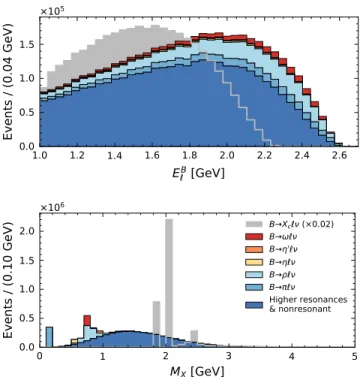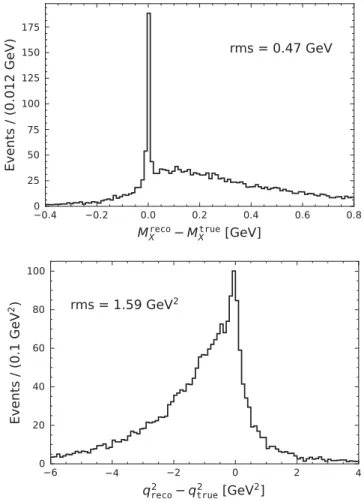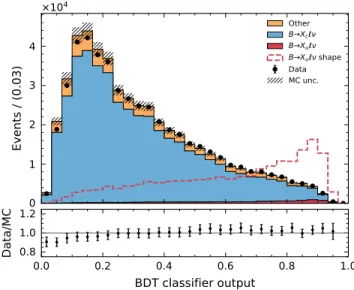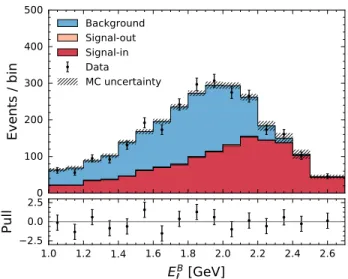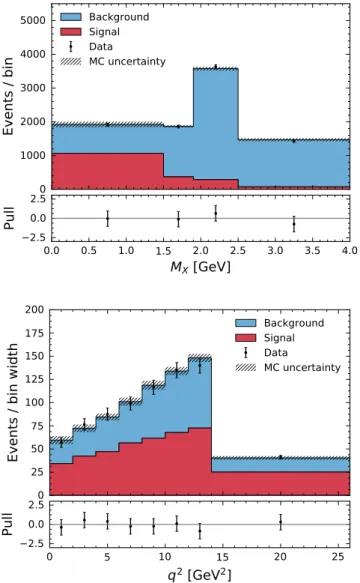35 Kavli Institute for the Physics and Mathematics of the Universe (WPI), University of Tokyo, Kashiwa 277-8583. The discriminant variables of the classification algorithm were carefully chosen not to introduce a bias into the measured partial branching fractions. A more detailed description of the detector and its layout and performance can be found in Ref.[27] and references therein.
We neglect the small contribution of Bþ→DðÞs Kþlþνl which has a branching fraction of similar size asB→Dππlþνl. The full four-momentum of the combination is transferred to the input layer. ΔE¼Etag−Ebeam ð11Þ is already used in the input layer of the neural network trained in the final stage of the reconstruction. 3We neglect the small correction of the lepton mass term to the energy of the lepton.
Note that all the impulses are in the center of mass frame of the colliding eþe pair. The reconstruction efficiency of the hadronic full reconstruction algorithm of Ref. [62] differs between simulated samples and the reconstructed data.
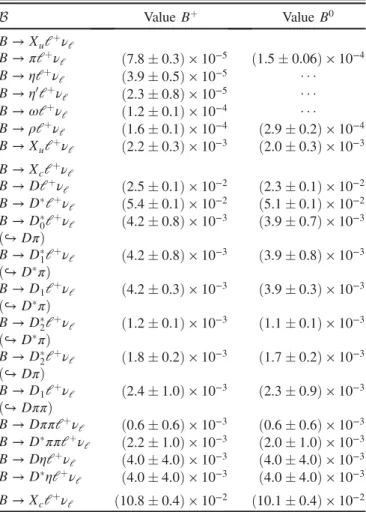
FITTING PROCEDURE
The main uncertainty of the Ctag factors is a consequence of the assumed composition B→Xlþνl and the action of the PID lepton, cf. These are derived by using an off-resonance sample and comparing the number of reconstructed off-resonance events in the data with simulated on-resonance continuum events, correcting for differences in selection. The determined signal yields are used to measure the fraction of partial branching with MX <1.7GeV, and the signal templates are split accordingly into the generator-level matched template and all other signal events.
The other fit also analyzes EBl, but uses the determined signal yields to measure the fraction of partial branching with EBl >1GeV. This fit also measures the fraction of partial branching with EBl >1 GeV and no separation into different categories of signal events is used. Lðˆηk;η;ˆ θÞˆ ; ð22Þ where ηˆk,η,ˆ θˆ are the values of the component of interest, the remaining components and an NP vector, respectively, that maximize the likelihood function, while the remaining components ηˆηand the nuisance parameters θˆηkmaximize the likelihood for the specific value ηk.
In the asymptotic limit, the test statistic (22) can be used to construct approximate confidence intervals. ΛðηkÞfχ2ðx; 1d:o:f:Þdx; ð23Þ with fχ2ðx; 1d:o:f:Þ, which characterizes the χ2 distribution of the variable x with a single degree of freedom. Furthermore, ϵsel and ϵΔBðRegÞ denote the signal side selection efficiency and the efficiency correction to account for the proportion of the B→Xulþνl region of the phase space that is measured.
The factor 4 in the denominator is due to the meson factor NBB ¼ ð771.589.78Þ×106B and our averaging over the electron and muon final states. To validate the fitting procedure, we created ensembles of pseudoexperiments for different input branching fractions for B→Xulþνlsignal andB→Xclþνlbackground. Fits with these ensembles show no bias in the central values and no under- or over-coverage of the CI.
SYSTEMATIC UNCERTAINTIES
Furthermore, the B→Xulþνl modeling affects the overall reconstruction efficiency and migrations of events inside and outside the phase-space regions we measure. We evaluate the uncertainty on the composition of the hybrid B→Xulþνl MC sample by variations of B→πlþνl, B→ρlþνl, B→ωlþνl, B→ηlþνl and B→η0lþνl branching fractions and form factors (FFs). The uncertainty on non-resonant B→ Xulþνl contributions in the hybrid model is estimated by changing the underlying model from that of DFN[54] to that of BLNP[17].
In addition, the uncertainty on the used DFN parameters m1Sb anda (cf. section II) is incorporated. We estimate the uncertainty of Xu fragmentation into quark pairs by variations of the corresponding JETSET parameter γs (cf. Ref.[57]). The Xu system of the non-resonant signal component hadronized by JETSET to final states with two or more pions.
We test the effect on the signal efficiency by changing the postfit charged pion abundance of non-resonant B→Xulþνl to the distribution observed in the data in the MX <1.7GeV signal-enriched region (cf. Section VIII E and Appendix C). We estimate the uncertainties in modeling B→Dlþνl, B→Dlþνl and B→ Dlþνl by variations of the BGL parameters and heavy quark form factors within their uncertainties. The uncertainties in the branching fractions of the B→Xclþνl gap are considered to be large enough to account for the difference between the sum of all measured fractions of exclusive branching and the measured fraction of inclusive branching.
We also estimate the impact on the efficiency of the uncertainties in the identification of leptons and hadrons and, more generally, the uncertainty of the tracking efficiency. Each element of this vector represents one bin of the fitted observations of interest (eg MX,q2, EBl or 2D bin MX∶q2). The covariance matrices Σks depend on the uncertainty vectors σks, which represent the absolute error in bins of the template fit variable k.
The agreement of MX and q2 is excellent, but some differences in the shape of the lepton momentum spectrum are seen.
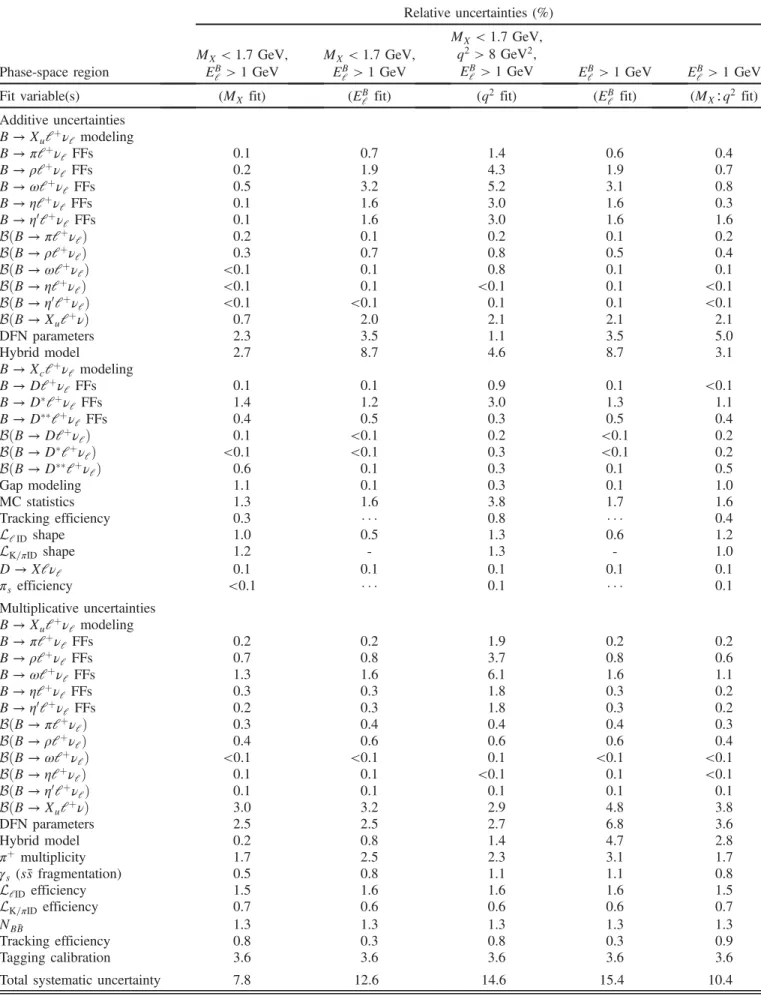
RESULTS
The resulting yields were corrected to correspond to the partial branching fraction with EBl > 1 GeV, with and without an additional requirement of MX < 1.7 GeV, respectively. The relationship between measured partial branching fractions, velocity predictions (without CKM factors) ΔΓðB → XulþνlÞ and jVubjis. ffiffiffiffiffiffiffiffiffiffiffiffiffiffiffiffiffiffiffiffiffiffiffiffiffiffiffiffiffiffiffiffiffiffiffiffiffiffiffiffi ffiffiffiffi ΔBðB → XulþνlÞ τB·ΔΓðB → XulþνlÞ s. The Bosch, Lange, Neubert and Paz prediction from Ref.[17,70,71] provides a prediction with the highest order accuracy in terms of the strength.
From the partial branching fractions with EBl >1 and MX<1.7 GeV determined by fittingMX, we find For the partially branched fraction with EBl >1GeV, MX<1.7GeV and q2>8GeV2 we find To check the stability of the result, we redetermine the partial branched fractions using two additional operating points.
To further assess the compatibility of the result, we determine the full statistical and systematic correlations of the results and find that the partial branched fraction with looser and stricter BDT selection matches the nominal result within 1.1 and 1.4 standard deviations, respectively. The accuracy of the fragmentation into the number of charged pions can be tested in the signal-enriched range MX<1.7GeV. The stability of a given partial branching fraction ΔBðB→XulνlÞ using the MX∶q2 fit is studied as a function of the BDT selection requirement.
We perform a simultaneous analysis of both samples so that common NPs for modeling signal or background components can then be correctly correlated. The effects of isospin breaking can be studied by separately measuring the partial branching fraction for the charged and neutral Bmeson final states. ΔBðB0→XulþνlÞ; ð40Þ using information from the fully reconstructed label side composition, the Bmeson is decomposed to separate charged and neutral B candidates.
This result is stricter than the limit of Ref.[15], but weaker than the result of Ref.[72], who directly used the shape of the q2 distribution to limit weak annihilation processes.
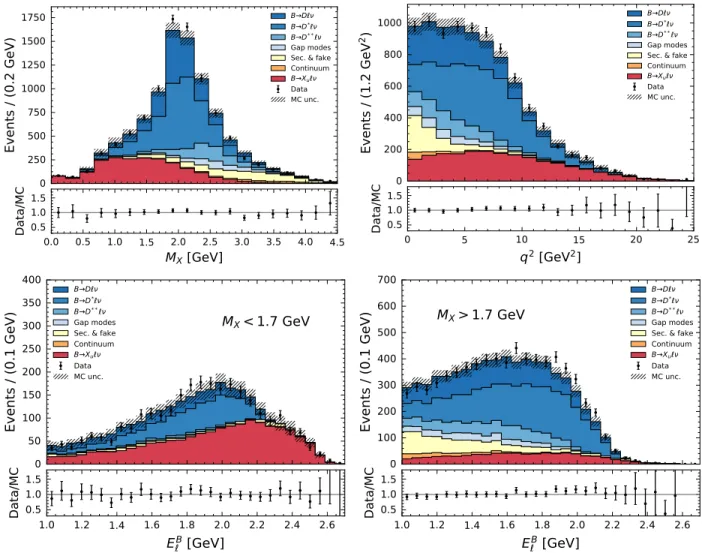
SUMMARY AND CONCLUSIONS We report measurements of partial branching fractions
ΔBðB→XuμþνμÞ ð39Þ with the first error indicating the statistical uncertainty and the second the systematic uncertainty. Our result is also weaker than the estimates of Refs.[73–76] which limit weak extinction contributions to the order of 2%–3%. The partial branching fraction is compatible with the value obtained by a fit of the lepton energy spectrumEBl and with the most precise determination of Ref.
We thank the KEKB group for excellent accelerator operation, the KEK cryogenics group for efficient solenoid operation, and the KEK computing group and the Pacific Northwest National Laboratory (PNNL) Environmental Molecular Sciences Laboratory (EMSL) computing group for powerful computing support and the National Institute for Informatics and Science Information NETwork 5 (SINET5) for valuable network support. We gratefully acknowledge the support of Japan's Ministry of Education, Culture, Sports, Science and Technology (MEXT), the Japan Society for the Promotion of Science (JSPS), and Nagoya University Tau-Lepton Physics Research Center; Australian Research Council, including grants no. 19ZR1403000; The Ministry of Education, Youth and Sports of the Czech Republic under contract no.
InterLeptons' (European Union); Carl Zeiss Foundation, Deutsche Forschungsgemeinschaft, Excellence Cluster Universe and VolkswagenStiftung; Ministry of Atomic Energy (Project Identification No. RTI 4002) and Ministry of Science and Technology of India; Istituto Nazionale di Fisica Nucleare of Italy; The National Research Foundation (NRF) of Korea grant no. Research Institute of Radiation Science, Support Project for the Use of Foreign Large Research Institutions, Center for Global Scientific Experimental Data Center of the Korea Institute of Information Science and Technology, and KREONET/GLORIAD; the Polish Ministry of Science and Higher Education and the National Science Center; Ministry of Science and Higher Education of the Russian Federation, Agreement 14.W and the Basic Research Program of HSE University, Moscow; University. Ikerbasque, Basque Science Foundation, Spain; Swiss National Science Foundation; Ministry of Education and Ministry of Science and Technology of Taiwan; and the USA
The shapes of the variables used in the BDT suppression of the background BDT are shown in Figures 14 and 17. We correct the multiplicity of charged pions at the generator level to match the value observed in this selection by the non- resonant B → Xulþνl events a correction weight as a function of the actual multiplicity of charged pions. The charged pawn multiplicity (nπ) is compared between data and the simulation: (top left) for all events prior to BDT selection; top right) for all events after the BDT selection; (bottom left) for the signal enriched region of MX<1.7GeV; (bottom right) for the same region, but after rescaling the non-resonant contributions so that the fragmentation probability π matches that observed in the data.
The fitted yields of the two-dimensional fit to MX∶q2 separated into electron and muon candidates as well as charged or neutral Bmesons are listed in Table VII. Figure 23 shows the BDT selection efficiency as a function of the reconstructed variables q2, MX and lepton energy EBl for simulated B→Xulþνl events. The efficiency B→Xulþν after BDT selection is shown as a function of the reconstructed kinematic variables (EBl,MX, q2) used in the signal extraction.
![FIG. 12. The obtained values of j V ub j from the four calculations and the arithmetic average is compared to the determination from exclusive B → πl þ ν l and the expectation from CKM unitarity [77] without the direct constraints from semileptonic and lep](https://thumb-ap.123doks.com/thumbv2/azpdfnet/10551630.0/21.918.84.444.739.980/calculations-arithmetic-determination-exclusive-expectation-unitarity-constraints-semileptonic.webp)
